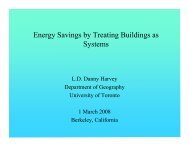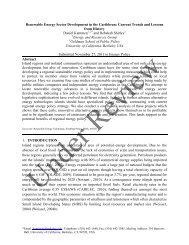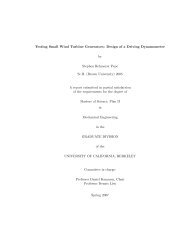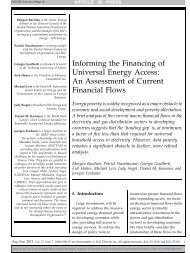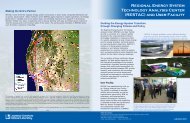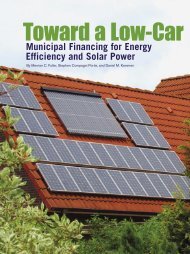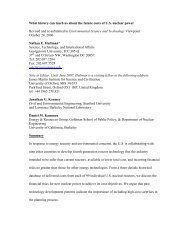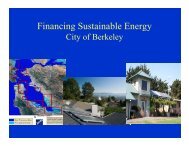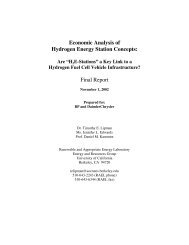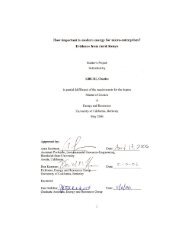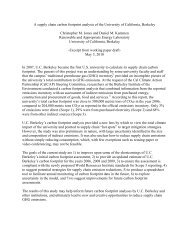Chapter 12 Energy for Development: Solar Home Systems in Africa ...
Chapter 12 Energy for Development: Solar Home Systems in Africa ...
Chapter 12 Energy for Development: Solar Home Systems in Africa ...
- No tags were found...
Create successful ePaper yourself
Turn your PDF publications into a flip-book with our unique Google optimized e-Paper software.
Richard D. Duke and Daniel M. Kammento various bus<strong>in</strong>esses, <strong>in</strong>clud<strong>in</strong>g the South <strong>Africa</strong>n utility ESKOM, Shell <strong>Solar</strong>, and the Dutch utilityNuon (Kammen, 1999; Anderson and Duke, 2001).Even complete saturation of the global SHSs market would have a negligible direct impact onglobal carbon emissions. Nonetheless, the CDM, or any similar mechanism that ultimately emerges,might provide an important boost to SHSs markets. As detailed below, carbon abatement creditsgenerated by SHSs could significantly reduce the price of solar electricity <strong>for</strong> rural households <strong>in</strong>develop<strong>in</strong>g countries.In addition to direct abatement (primarily through displacement of kerosene light<strong>in</strong>g, batterycharg<strong>in</strong>g, and to a lesser extent, generators), SHSs may also yield <strong>in</strong>direct carbon emissionsreductions. First, SHSs are a near-term niche market <strong>for</strong> photovoltaics (PV). As such, SHS sales helpto drive the virtuous cycle between (i) cost reductions from greater PV production experience; and (ii)<strong>in</strong>creased global demand <strong>for</strong> PV due to those cost reductions (Duke and Kammen, 1999a). As a resultof these dynamic effects, the <strong>Africa</strong>n SHS market itself may marg<strong>in</strong>ally contribute to ef<strong>for</strong>ts to reducethe global price of PV – though major programmes to subsidise grid-connected residential andcommercial markets <strong>in</strong> Japan, Germany, and other <strong>in</strong>dustrialised countries <strong>in</strong>creas<strong>in</strong>gly dom<strong>in</strong>ateglobal PV markets (Duke, 2002).Another <strong>in</strong>direct carbon benefit associated with SHSs is that they may delay or displaceconventional grid extension. There is no sure-fire technique <strong>for</strong> estimat<strong>in</strong>g the magnitude of thiseffect, but it appears to be operative <strong>in</strong> the South <strong>Africa</strong>n context (Anderson and Duke, 2001).These <strong>in</strong>direct market trans<strong>for</strong>mation and grid displacement benefits are unlikely to be sufficientlyquantifiable to generate certified CDM credits, but they may motivate SHSs <strong>in</strong>vestments and supportfrom public and private funders <strong>in</strong>terested <strong>in</strong> promot<strong>in</strong>g carbon abatement.2. LEARNING AND EXPERIENCE CURVESLearn<strong>in</strong>g curves describe the relationship between cumulative production of a manufactured good,such as PV, and the labour <strong>in</strong>puts necessary per unit produced. 1 Dur<strong>in</strong>g the 1970s, Boston Consult<strong>in</strong>gGroup (BCG) generalised the labour productivity learn<strong>in</strong>g curve to <strong>in</strong>clude all costs necessary toresearch, develop, produce and market a given product (Boston Consult<strong>in</strong>g Group, 1972). That is,BCG argued that learn<strong>in</strong>g-by-do<strong>in</strong>g occurs not only <strong>in</strong> the narrow sense of labour productivityimprovements, but also <strong>in</strong> associated R&D, overhead, advertis<strong>in</strong>g and sales expenses.These efficiency ga<strong>in</strong>s, <strong>in</strong> conjunction with the benefits from scale economies, often yield costreductions characterised by an experience curve:UC = a •q −bWhere UC = unit cost, q = cumulative production, a = the cost of the first unit produced, and b = theexperience parameter. 2 The underly<strong>in</strong>g <strong>in</strong>tuition <strong>for</strong> this exponential relationship is that there aredim<strong>in</strong>ish<strong>in</strong>g returns to experience. Cost reductions are fast <strong>in</strong>itially, but taper off as workerproductivity becomes optimised, production is fully scaled up, <strong>in</strong>cremental process improvements aremade, and so on.Table 1. A taxonomy of learn<strong>in</strong>g-by-do<strong>in</strong>g terms.Labor Costs Only All CostsNo spillover Firm-specific learn<strong>in</strong>g curve Firm-specific experience curvePerfect spillover Industry learn<strong>in</strong>g curve Industry experience curve1 This section draws from Duke and Kammen (1999a).2 See Hirschman (1964), Argote and Epple (1990), and Badiru (1992) <strong>for</strong> variants of the equation. Also, Arrow (1962) uses cumulativecapital goods <strong>in</strong>vestment as the learn<strong>in</strong>g proxy.



